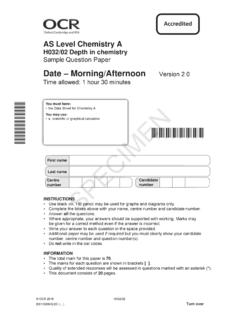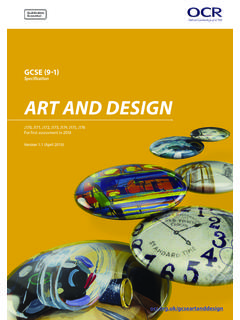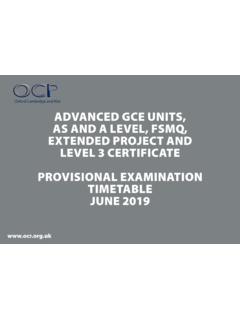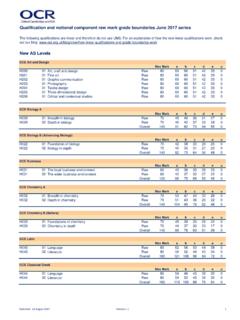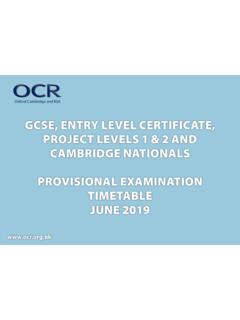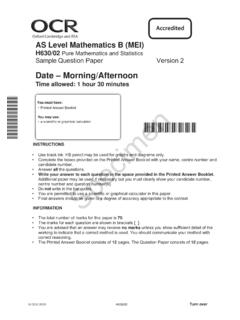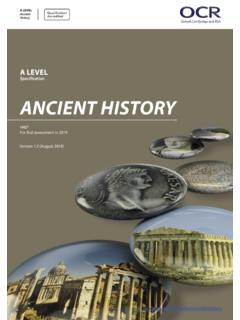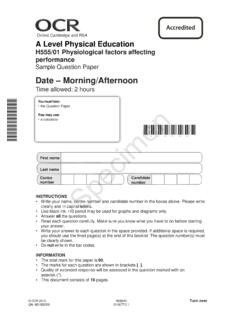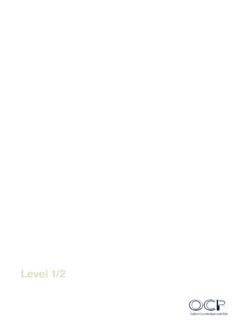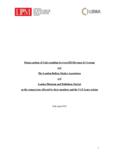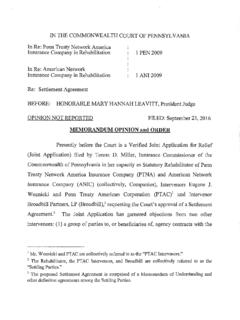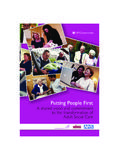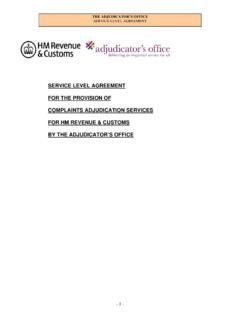Transcription of J351/J352 ENGLISH LANGUAGE AND ENGLISH …
1 GCSE (9 1). Delivery Guide J351/J352 . ENGLISH LANGUAGE . AND ENGLISH . LITERATURE. Theme: ENGLISH LANGUAGE and Literature 19th century texts April 2015. We will inform centres about any changes to the specification. We will also publish changes on our website. The latest version of our specification will always be the one on our website ( ) and this may differ from printed versions. Copyright 2015 OCR. All rights reserved. Copyright OCR retains the copyright on all its publications, including the specifications. However, registered centres for OCR are permitted to copy material from this specification booklet for their own internal use. Oxford Cambridge and RSA Examinations is a Company Limited by Guarantee. Registered in England. Registered company number 3484466. Registered office: 1 Hills Road Cambridge CB1 2EU. OCR is an exempt charity. GCSE (9 1). ENGLISH LANGUAGE AND ENGLISH LITERATURE. CONTENTS. Introduction Page 4. Curriculum Content Page 5. Thinking Conceptually Page 7.
2 Thinking Contextually Page 10. Learner Resources Page 15. 3. Introduction Delivery guides are designed to represent a body of knowledge about teaching a particular topic and contain: KEY. Content: a clear outline of the content covered by the Click to view associated resources delivery guide; within this document. Thinking Conceptually: expert guidance on the key concepts involved, common difficulties students may have, approaches to teaching that can help students Click to view external resources understand these concepts and how this topic links conceptually to other areas of the subject;. Thinking Contextually: a range of suggested teaching activities using a variety of themes so that different activities can be selected that best suit particular classes, learning styles or teaching approaches. If you have any feedback on this Delivery Guide or suggestions for other resources you would like OCR to develop, please email 4. Curriculum Content In studying GCSE ENGLISH LANGUAGE , candidates will need to be able to show that they understand writers' meanings and purposes by responding to thematically linked unseen texts or extracts.
3 In Component 1, Communicating information and ideas, one of the texts is drawn from a 19th century non-fiction source. This may include different types of journalism, travel writing, autobiography and persuasive texts such as speeches. AO1 Candidates should be able to: identify and interpret explicit and implicit information and ideas select and synthesise evidence from different texts. AO2 Candidates should be able to: explain, comment on and analyse how writers use LANGUAGE and structure to achieve effects and influence readers, using relevant subject terminology to support their views. AO3 Candidates should be able to: compare writers' ideas and perspectives, as well as how these are conveyed, across two or more texts. AO4 Candidates should be able to: evaluate texts critically and support this with appropriate textual references. 5. Curriculum Content In studying GCSE ENGLISH Literature, students will study one 19th century novel from a choice of five. AO1 Candidates should be able to: read, understand and respond to texts.
4 Students should be able to: maintain a critical style and develop an informed personal response use textual references, including quotations, to support and illustrate interpretations. AO2 Candidates should be able to: analyse the LANGUAGE , form and structure used by a writer to create meanings and effects, using relevant subject terminology where appropriate. AO3 Candidates should be able to: show understanding of the relationships between texts and the contexts in which they were written. 6. Thinking Conceptually This delivery guide looks at the crossover potential when delivering the ENGLISH LANGUAGE and Literature GCSEs by spotlighting links between the 19th century set texts that form part of the GCSE ENGLISH Literature course and non- fiction mined from that era. The guide comprises activities in which 19th century essays, diaries and memoranda are employed for a dual purpose: to hone students' LANGUAGE analysis skills and to contextualise the 19th century fiction being studied.
5 Your students could begin this exploration of texts by picturing a forest where lush vegetation grows. The plants and trees they see are the themes that recur through time - in fiction and non-fiction. The themes that we're stuck on and grapple with endlessly: fear of invasion, our jitters when scientific frontiers are breached, marriage and dual identity. Themes that 19th century texts are shot through with. These themes are explored in conversation, in literature, The seams represent different evolutionary stages, the skewed in newspapers, music and film until seemingly definitive and clear-sighted perspectives of both real and fictional solutions or interpretations flower. But they date as more characters on invasion, marriage, scientific advance and dual enlightened or conservative thought encroaches; as dumbed- identity, all fossilised and caught for posterity in these seams down or more sophisticated or more fashionable riffs on a of coal. theme catch on instead. It probably looked like Robert Louis Tell your students to imagine mine shafts drilled beneath Stevenson had dual identity nailed when The Strange Case of each of the trees in the forest, down which they will descend Dr Jekyll and Mr Hyde was published in 1886.
6 But Beyonc and through the different seams, each one full of all the fiction and her alter-ego Sasha Fierce, the Incredible Hulk and internet non-fiction, the music and film that the theme inspired during trolls are channelling rebooted versions of the theme too. say a specific year. But the old interpretations don't disappear. They're caught in At certain points students can cut the coal from the seam and print and on YouTube, like seams of coal building below the haul it back to the surface, forest. 7. Thinking Conceptually Let's look at the idea of invasion. In seam 1882 they will hear Lord Wolseley shouting down plans for a Channel Tunnel, arguing that Dover could be seized by enemy soldiers disguised as passengers on a train. Had they chosen to stop in seam 1898 the coal would contain HG Wells' The War of the Worlds. For our purposes comparing 19th century non- fiction and 19th century ENGLISH literature, we would halt the exploration of the seams there. But students could mine the seams closer to the surface too.
7 In seam 1907, for example, they would find this HM Brock illustration for AJ Dawson's anti- German invasion scare novel The Message: where they will break it open and find their theme, fossilised at that point in time. Further towards the surface, in 1956, they would find a lobby card from the Invasion of the Body Snatchers film: Click here 8. Thinking Conceptually And further towards the surface, in 2002, they would find the of Dr Jekyll and Mr Hyde, with much being made of Mr Hyde's following Evening Standard front page splash prompted by the hideous appearance connoting the evil inside him. If we claim in the September Dossier that Sadaam Hussein could join the dots, rising up the mine shaft past Aldini, Shelley, fire weapons of mass destruction at the UK within 45 minutes, Lombroso and Robert Louis Stevenson, we arrive in 2007. a claim that would lead to the invasion of Iraq. Read about this where we find Kazuo Ishiguro's dystopian novel on genetic here: farming, Never Let Me Go, one of the modern texts for GCSE.
8 Click here ENGLISH Literature. As well as 19th century fiction, there is scope to link other So that their reading branches in as many directions as modules from the ENGLISH Literature GCSE to the ENGLISH possible, students should be encouraged to see that themes LANGUAGE GCSE using this methodology. Modern texts overlap and hybrids emerge. This delivery guide contains for instance. Let's consider the theme of our anxiety when activities that promote this. For example, in 1972, a hybrid of scientific frontiers are pushed and follow it through to one of The Strange Case of Dr Jekyll and Mr Hyde dual identity theme the modern set texts. At the beginning of the 19th century and The War of the Worlds invasion theme appeared in the there was Giovanni Aldini wowing crowds by reanimating form of David Bowie's alien alter-ego Ziggy Stardust. executed criminals with jolts of electricity. Cue Mary Shelley's If students are inspired to make these links, wider reading will cautionary tale Frankenstein.
9 Darwin's evolutionary theories be facilitated. Their investigations will lead them from one text fuelled atavistic scare stories: if we could evolve from apes we through another and on in multiple directions. This delivery might regress too. Criminal anthropologist Cesare Lombroso guide provides ways of approaching 19th century texts that performed experiments that set out to prove that born can be adapted to suit a range of interests and abilities to criminals' were physically different from so-called ordinary encourage students to enjoy their investigations of different people or occasional criminals': they had more wrinkles and texts. different physical forms, even passed more urine than ordinary people, he claimed. Born of this climate was The Strange Case 9. Thinking Contextually The activities in this guide help to develop the skills needed for both the GCSE ENGLISH LANGUAGE and GCSE ENGLISH Literature courses. Unseen 19th century non-fiction texts are used to contextualise the 19th century fiction in GCSE ENGLISH Literature, giving students the confidence to analyse both set texts and unseen texts.
10 Activities focus on a comparison of the themes and ideas running through both, tackling ENGLISH LANGUAGE and ENGLISH Literature AO3 in tandem. A further strand of activities addresses AO1 and AO2 for both GCSE qualifications, and AO4 for ENGLISH LANGUAGE , by focussing on the use of LANGUAGE for impact in both the fiction and non-fiction, equipping students with subject terminology and encouraging them to form personal judgements about the texts in order to develop critical evaluation skills. Writing tasks are also provided as extension activities. This guide looks at the following themes: Invasion Marriage Scientific advance Dual identity/appearance. The theme of invasion in The War of the Worlds is accessed via a 19th century memorandum from Lord Wolseley about the security risks around building a Channel Tunnel; the theme of marriage in Jane Eyre and Pride and Prejudice is looked at through the prism of a 19th century death-bed wedding; the idea of pursuing scientific or medical knowledge for selfish motives is explored in The Strange Case of Dr Jekyll and Mr Hyde via the diary entries of a resurrectionist; the theme of dual identity/.
